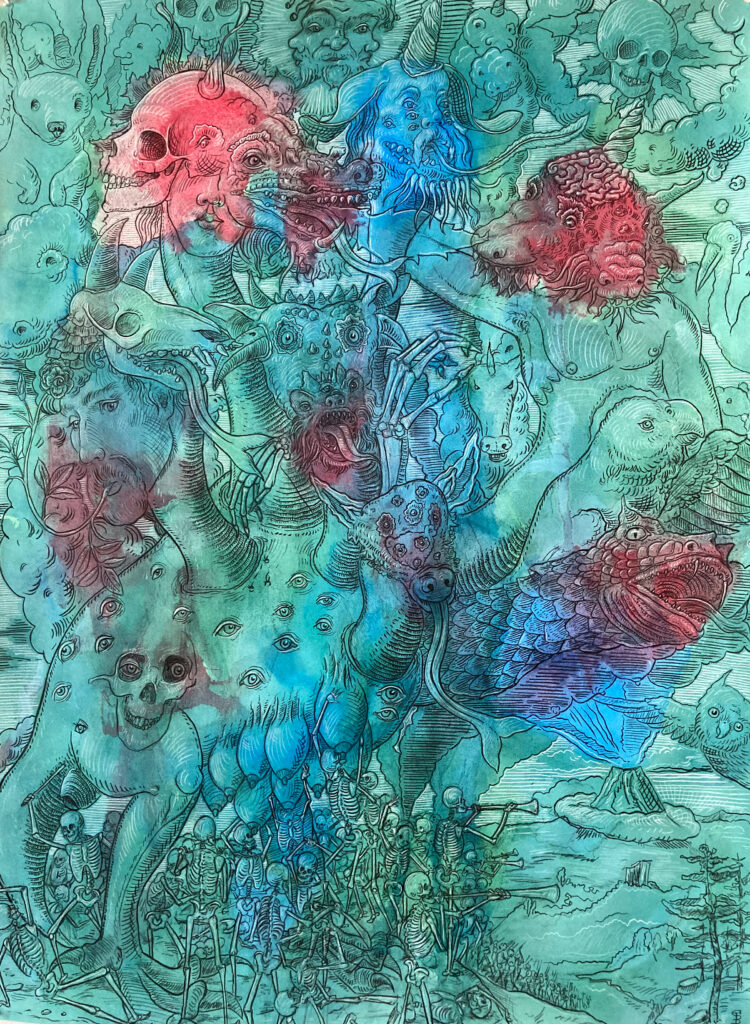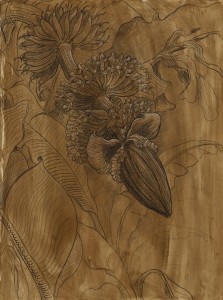
Biography
(American, born 1962)
Artist Statement
These works were created using improvisatory methods- ink washes of red, blue and green were laid semi-randomly on the paper. While I have an idea of what I will draw I deliberately leave the washes rough, inviting accident, hitting the “wrong” notes. Once dry, the forms suggested in the crenelated pigment are picked out using vine charcoal- a medium easily erased and adjusted. Conté crayon in black and white are then added to define the forms. This is my methodology, which harkens all the way back to Leonardo Da Vinci’s admonition ‘to rouse the mind to new inventions’ by looking at stained walls, clouds and the like. But even before I encountered the genius of Leonardo; since I was a small child, I have found it easy to “see” in this way, to find faces, figures and animals in woodgrain and clouds. Learning to use this imagery has taken me much longer.
In this recent work The Dragon of the Apocalypse and A Whale’s Dream in the Anthropocene I have tried not to edit the imagery, to let the imagination run a bit wild, to plumb the unknown, to give breath and depth to the imagination, to challenge myself to think differently about how I communicate. It is a way of being in the moment that I have found essential to finding my voice.
I want to create images that simultaneously frighten and entrance. I want to make it clear to the viewer that it is time to pay attention if we wish not to follow the Ivory-billed Woodpecker, the Dodo, the Great Auk into oblivion. It is clear now that our writing and language have not prepared us for the challenges and crises of our current world. In fact, language has been used to cleverly obscure the very real and pressing issues of our time. We are at a precipice; species are disappearing before they have even been discovered in the Anthropocene, the great whales are dying off, their populations a shadow of what they once were—We seem incapable of the drastic actions necessary to stop the destruction and yet…the arts, creating images that speak to the current climate chaos just may help nudge our collective consciousness into action.
Artist Statement
There is nothing more beautiful or more tragic than the human condition. In the fragile container of the body we make our way.
 The literature and imagery of mythology and religion express and give form to our desires and conflicts. As such I have found they are the perfect vehicles to explore my fascination with the human form. Reflecting the world of the spirit through the corporal state, the body has a miraculous ability to convey psychological depth without words. I have sought to harness this quality through meticulous attention to images that highlight this distinction. The underlying life inherent in all things can be shown. Art, like science, builds on the achievements of the past. As each era breaths life into the next, ways of seeing are developed to mirror the needs and desires of the time.
The literature and imagery of mythology and religion express and give form to our desires and conflicts. As such I have found they are the perfect vehicles to explore my fascination with the human form. Reflecting the world of the spirit through the corporal state, the body has a miraculous ability to convey psychological depth without words. I have sought to harness this quality through meticulous attention to images that highlight this distinction. The underlying life inherent in all things can be shown. Art, like science, builds on the achievements of the past. As each era breaths life into the next, ways of seeing are developed to mirror the needs and desires of the time.
The works I create are a result of a labor-intensive meditation exploring this evocative history of bodily images and the passage of time. Utilizing the ornamental, landscape, and figurative motifs of the 15th and 16th centuries, I have adapted elements of the periods vernacular graphic syntax as a means of creating images which suggest, in their essence, the possibility of transcendence from the present state. Among writers, Ovid’s polysemic treatment of human emotion and irrationality, is an essential inspiration, among artists, Schongauer, Mantegna, Dürer, Holbein, and Rubens. Their emblematic visions of the struggles of the mind and body remain a springboard to innovation and expression.
My interest in (now somewhat) anachronistic technique lies in its ability to shift the consciousness of both the artist and the viewer in creating images that require both labor- intensive process and contemplative viewing to draw out complex internal rhyme and rhythm. Each mark, expressive and ultimately revealing, reveals the trace of the artist’s movement and life, yet also creates the illusion of a separate life. This act of creation is still, after many years, incredibly fascinating.
I choose to represent the human body nude to highlight the complexities of the narrative form. Without clothes the body is without its mantle of convention. Seen as it is, the body is the locus of desire that will always, as long as we remain connected to our humanity, engage both our higher senses of beauty and more base desires. In investigating the core elements of the language of sign and symbol through the lens of the body and landscape, I believe it is possible to then create archetypes of human aspirations and passions. Once so engaged, the viewer can enter into a psychologically intensive dialogue that extends beyond expected satisfactions.
